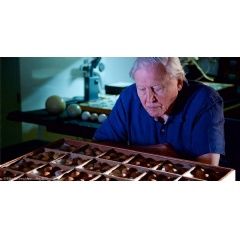Sir David Attenborough films new documentary at Museum
The broadcaster visited Natural History Museum collections to create a documentary revealing the wonder of birds’ eggs.
Attenborough’s Wonder of Eggs is expected to feature new research into eggs and the remarkable structure of these miracles of nature.
Eggs nurture new life, protecting embryos from the outside world while allowing them to breathe. They are strong enough to withstand the full weight of an incubating parent and weak enough to allow a chick to break free.
But how is an egg made? Why are they the shape they are? And perhaps most importantly, why lay an egg at all? Piece by piece, from creation to hatching, Sir David will answer these questions.
Researching the oldest eggThe documentary includes the story of new research at the Museum on one of the most iconic lost birds, the great auk (Pinguinus impennis).
The great auk was once widely spread across the North Atlantic in Canada, Greenland, the Faroe Islands and Iceland to Ireland, the UK, Denmark and European Russia.
Flightless, tasty and easy to kill at their breeding colonies, these seabirds were slaughtered relentlessly for food, feathers and fat. The last great auk was killed and its single egg taken by local men on the island of Eldey, off the south coast of Iceland, in 1844.
The few specimens held in museum collections across the world are now the only way to research this extraordinary animal.
The Museum holds six of the 75 known great auk eggs that remain. One of these is approaching 250 years old and is one of the oldest eggs in the Museum. It is among the eggs now being researched using one of the most cutting-edge technologies.
Douglas G D Russell, Senior Curator of Birds’ Eggs, says,’ Our research on the shape, colour and design great auk eggs, and comparisons with those of its living relatives (the razorbill, common guillemot and Brünnich’s guillemot), are helping us piece together unknown aspects of this remarkable bird’s biology.’
Old specimens meet new technologyConducting research on great auk eggs is difficult because they are so fragile, but new technology is allowing researchers to safely work on them.
The Museum has a 3D X-ray microscope that allows researchers to study objects in unprecedented detail without damaging them.
In 2017 staff at the Museum embarked on a groundbreaking project with the University of Sheffield to compare the microstructure of three of the best-preserved great auk eggshells to that of their living relatives to gain incredible insight into their breeding ecology.
But applying these new techniques to specimens can be complex, and it needed the help of the Museum’s conservation team and Imaging and Analysis Centre.
Douglas says, ’Moving these fragile, rare eggshells within the confined, potentially harsh, mechanised environment of the microscope and ensuring the correct position and orientation of each egg to image the eggshell was challenging.’
To solve this problem, the team custom-built a mould to protect the eggs while they were in the microscope.
The eggs were surface-scanned using a handheld structured light scanner. Scan data was then used to 3D-print exact replicas of the specimens. These replicas were used to mould a two-part hard case which could be used to hold the egg for the duration of the project.
This system successfully protected these fragile specimens throughout dozens of scans.
Research resultsResearchers Duncan Jackson and Prof Tim Birkhead at the University of Sheffield are still analysing results and investigating the adaptive significance of bird eggshell architecture.
Tim has been studying birds’ eggs, in particular those of the auks, for the last five years. His award-winning book, The Most Perfect Thing: Inside (and Outside) of a Bird’s Egg, provides the basis for the great-auk egg research, and for the BBC documentary.
Discover more about what his research is showing in Attenborough’s Wonder of Eggs, airing on BBC Two at 20.00 on Saturday 31 March.
( Press Release Image: https://photos.webwire.com/prmedia/7/222052/222052-1.jpg )
WebWireID222052
This news content was configured by WebWire editorial staff. Linking is permitted.
News Release Distribution and Press Release Distribution Services Provided by WebWire.
